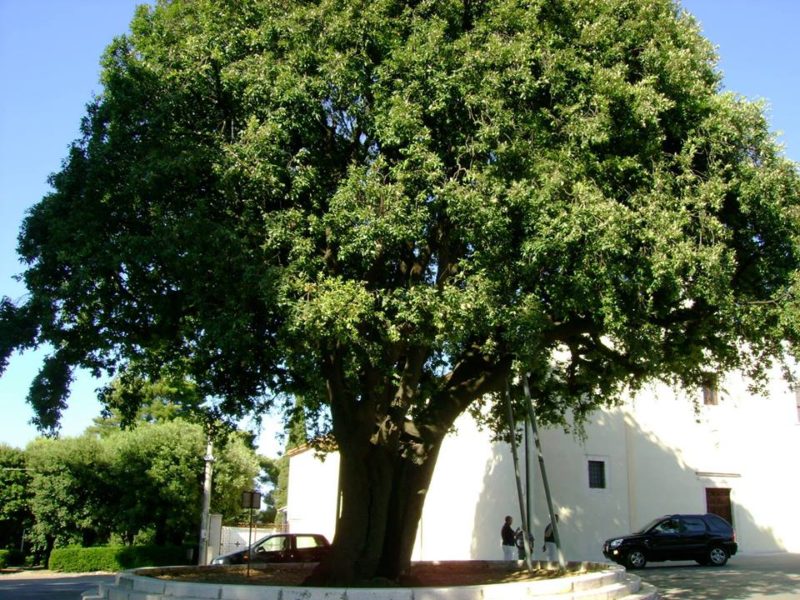
Holm oak of the Capuchins
This post is also available in:
 Italiano (Italian)
Italiano (Italian)
Quercus ilex (Fagaceae)
Classified as an “example of exceptional historical and monumental value” by the State Forestry Corps, this magnificent holm oak is located next to the Capuchin convent of Vico del Gargano.
This monumental tree was already acknowledged at the end of the 1900s by Adriano Fiori, one of the leading experts of Italian and European botany.
The holm oak of the Capuchins is a centuries-old tree: a commemorative plaque reports that it was planted by a Capuchin friar, Fra’ Nicola da Vico del Gargano and then blessed by his Father Superior. This story dates back to some 300 years ago.
Looking at the holm oak from a distance, visitors can quickly spot its true majestic bearing, with a dark green foliage that can reach a width of 164 ft. When closer to the tree, its mighty trunk features a circumference of 16.5 ft and, unfortunately, a huge longitudinal gash and a missing branch, broken by a storm in 1934.
The inevitable wood decay requires thorough tree surgery to safeguard this spectacular monumental specimen.
How to get there:
Walk to the historic city centre of Vico del Gargano (FG) and then reach the SS. Crocifisso Convent of the Capuchin Friars: the monumental tree grows in the in the square in front of it.
Dal comune di si raggiunge, a pochi passi dal centro storico, il Convento del SS. Crocifisso dei Frati Cappuccini, l’albero monumentale si trova nel piazzale antistante.
Botanical Card:
The holm oak is a tree which can grow up to 82 ft, with an evergreen, dense, globular and slightly expanded crown. The leaves are alternate, persistent, leathery, and grow in many different shapes – they can be as long as 2.75 inches, with a short petiole. Their upper side is glabrous, dark green and shiny, while below it appears rugged and whitish. The acorn can be as long as 1.18 inches.
It is a thermophilic species typical of the Mediterranean scrub, found from sea level up to 600 m (1500 m in the Apennines) on soils not too rich in clay.
In Italy, this species is most widespread in the Ionian and Tyrrhenian regions, as well as on the major islands, while on the Adriatic side it is found quite sporadically.
There are two groups of relic trees belonging to warmer periods on the Euganean Hills and around the city of Ferrara. The northernmost point of growth of the holm oak is in the Carnic Prealps, on vertical cliffs exposed to the south.
The holm oak is an evergreen plant with leathery leaves that form a dark green crown.
The species is xerotolerant, prefers protective shading in the juvenile phase and adapts well to different types of soils but avoids clayey-compact ones with any water stagnation.
The holm oak grows throughout the Mediterranean basin but in Egypt, while in Libya it was probably introduced by man. However, it is a species more widespread in the western part of Northern Africa, especially in Algeria and Morocco, throughout the Iberian peninsula (where it is one of the main trees in the Dehesa (a multifunctional, agricultural system).
In Mediterranean France and Italy, it tends to grow in single-species woods of remarkable considerable size. Farther east, starting from the Balkans, it can be found in mixed woods and only on soils with adequate humidity. The same thing happens along the Turkish coasts of the Black Sea.
In Italy, the Quercus ilex is most widespread on the islands and along the Ligurian, Tyrrhenian and Ionian coasts; on the Adriatic side, tree populations are more sporadic and disjointed (except for Puglia, Abruzzo and Marche).
Small groves are also present in the Prealps along the lake shores of the lakes, in the Euganean Hills, in Friuli-Venezia Giulia, in Romagna up to the Bolognese-Imola territory, and in the Mesola wood (around Ferrara).
The holm oak is the Mediterranean tree par excellence, present spontaneously in all regions of Italy except in the Aosta Valley, but much more abundant in Mediterranean Italy.
The holm oak is widely used as an ornamental plant, in parks and / or large gardens.
It is well suited for urban green areas, tree-lined streets, embankments and noise barriers.
Well tolerating the pruning, it can be grown as a sapling and used in small gardens or along the avenues. It also grows well near the sea and it is widely used for reforestation of exposed, uncultivated and hilly areas in central-southern Italy.
The wood is hard and difficult to process and season as it tends to warp and split. It was once used to build tools or parts of farming wagons due to its extreme durability. It can be used as excellent fuel or very good coal.
This species is grown mainly in coppice for the production of firewood; it grows well even difficult soils, while its sucker regeneration is much better than that of deciduous oaks.
In the past, the acorns were used to prepare a surrogate of coffee and as fodder for pigs, rabbits, goats, turkeys, and other poultry. Sturdy handles for hoes were often made with holm oak wood as well.
Photo source:
http://vicoinfoeventi.altervista.org/storialeggendevico-del-garganoil-leccio-del-frate-santo/
This post is also available in:
 Italiano (Italian)
Italiano (Italian)
Contatti
71018 Vico del Gargano(FG)
